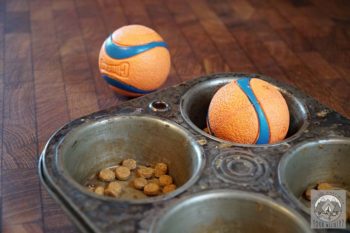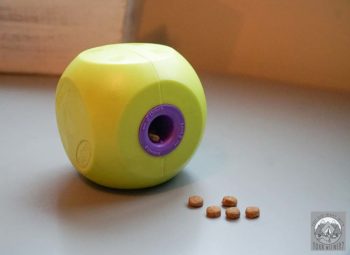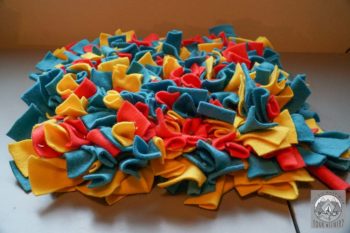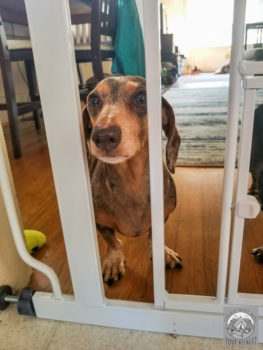9 Ways to Help Stop Your Dachshund from Eating too Fast
My Dachshund Gretel has always eaten her dog food too fast. She practically inhales it.
It’s “funny” to watch, and it’s something Dachshund owners often joke about because it’s common in the breed, but a dog eating their food too quickly can actually have serious consequences.
What Can Happen If Your Dog Eats Food Too Fast?
If your dog eats their food too quickly, it can cause:
- Bloat (which isn’t very common in Dachshunds but can happen)
- Choking
- Gagging
- Vomiting
Gretel scarfing her dog food has always worried me a little because of these potential consequences so I researched what I could do to slow down her eating.
Note: some of the links below are affiliate links, which means that we get a few pennies if you make a purchase, at no extra cost to you, to help support this blog (and we really, really appreciate it!).
9 Ways to Slow Down Your Dachshund’s Eating
Not all of these methods below will prevent your Dachshund from eating their food too fast but they are worth a try. Usually at least one of these things works.
Add Water, Another Liquid, or Puree
I actually discovered this one on my own by accident.
I mixed 1-2 tablespoons of canned (unsweetened) pumpkin in Gretel’s dry kibble with the intent of helping her with some digestion issues.
It made kind of a “paste with kibble” that I spread over the bottom of the bowl and up the sides a little.



To my surprise, it took Gretel at least a minute to eat her food (it was taking her under 5 seconds before).
While it doesn’t work for every dog, adding something to their food to make it more sticky or kind of like bobbing for kibble if you use a liquid (they have to drink the liquid first and/or “catch” the kibble), is a quick and cheap option that could help prevent your dog from eating too fast.
Some things to try in your dog’s food to make them “sticky” are:
- Unsweetened pumpkin puree (bonus: it helps with digestion, diarrhea, or constipation)
- Plain yogurt
- Bone broth
- Goat’s milk (plus: helps aid digestion, con: can add significant extra calories so you’ll want to reduce the food amount just a little.)
Use Food for Training
There aren’t any rules that sat rewards for training have to be treats.
A common practice in the dog training world is to reduce the amount of kibble a dog is eating at each meal and use the remaining amount of food for training throughout the day.
Not only will this help to keep your dog a healthy weight while training, it can help keep them engaged and mentally stimulated.
Sometimes, treats are given for positive behavior that should be reinforced, like calm play, or checking in when going for a walk together.
Other times, it can be used for more formal training, like sit or lay down.
It can also be used for fun “training” games like scent training.
To incorporate scent training into your dog’s routine, grab some boxes and other containers (like brown paper bags, paper towel rolls and even balled up tissue paper), hide some food in them (and possibly some other treats, that may be more smelly), and spread the boxes throughout your home or backyard.
As your dog finds the boxes with goodies they will have to nose through and find their way to the food.
This activity is great for when the days are shorter, the weather is colder, and you want to keep your dog active and mentally stimulated but can’t go outside for hikes or other activities.
Feed Your Dog Meals by Hand
This is related to the one above but instead of feeding regular meals and using some of their food for training, you feed your dog their entire meal by hand, one piece of kibble, or one morsel of raw food, at a time.
Feeding this way ensures you can control how fast your dog is eating their meal.
A bonus of feeding them this way is that it can help with bonding, your dog’s willingness to pay attention to you, and make training other commands like “come” easier.
Create a Makeshift Slow Feeder
Got a smaller bowl that can fit inside your dog’s food bowl? You can turn it over and place it inside the other bowl.
Your dog will be required to nose around the bowl to get to the food.
You can accomplish this same concept by adding a rubber (non squeaking) ball or dog toy. However, some dogs can grow wise to this tactic and simply take the ball or toy out of the bowl and eat at the same fervent pace (that’s what Gretel did when I tried this *ahem*).
An upturned bowl inside a bowl is a bit more difficult to remove.
Use Baking Supplies
If you have a baking tin, serving tray, or any long and flat container with an edge that will keep food in a contained area, you can spread its food out on the surface.
You can also use a cupcake tin by placing the food inside each compartment (bonus difficulty if you set a ball on top they have to remove to get to the food).

This will force your dog to slow down as it sniffs around for its food.
To add another layer of engagement and entertainment, you can use a muffin tin and cover the tops with toys or balls. Your dog will have to stop and remove the obstruction before getting to the food, which will slow down its eating.
Use a Slow Feeder
There are specific bowls on the market that can help slow your dog’s feeding.
Slow Feeders often have slits or bumps that your dog needs to find a way to work around to get to the food. Adding liquid creates another layer that can help to slow your dog down, too.
Not all Slow Feeders are created equal. Depending on your dog, they may quickly find a way to maneuver around the feeder to get to the food.
I’ve seen some dogs simply knock the bowl over with their nose and scarf the food once it was on the floor.
Looking for one with a wide base that is a bit more difficult to knock over may be a consideration when making a purchase.
Have Your Dog Solve a Puzzle
Food dispensing toys, like the Buster Food Cube, and puzzles help to make your dog solve some problems before allowing access to the yummy food inside.

A food-dispensing toy can be as simple as using a ball with a hole inside. As your dog noses the ball around on the floor, food falls out for your dog to nibble on.
Some dispensing toys are more involved than others, so if your dog quickly figures this out, you can upgrade to other toys.
There are dog food puzzles, too. Some puzzles have compartments that your dog has to find a way to open through using its paw or nose or mouth.
There are quite a few that can be changed to varying levels of difficulty so your dog continues to be challenged as time progresses.
Even if you have a dog that doesn’t eat too quickly, using puzzles can still be a great addition to add to your routine. This mental stimulation and problem solving is helpful in keeping your dog happy, engaged, and rewarded.
There’s a Mat for That
Remember shag carpeting? Imagine dropping an earring in shag carpeting and trying to find it. It would be difficult because the pile is long so things can be hidden.
You can achieve the same scenario using something called a Snuffle Mat.

These mats have pieces of fabric that have been tied to a base that’s about the size of a bath mat.
If you sprinkle your dog’s dry food on the mat, the bits of food fall between the pieces of fabric meaning your dog will have to use its sniffer to find the food and eat it.
Be Consistent and Recognize Triggers
Sometimes Dachshunds are eating quickly because of environmental triggers. If you address the environmental trigger, it could be enough to help change the behavior of eating too quickly.
For example, if your feeding schedule is sporadic or you’re only feeding them one large meal, your dog is either unsure of when the next meal is coming or is super hungry by the time their food arrives.
These two scenarios can result in your dog eating too fast because they either literally don’t know when to expect the next opportunity to eat or are just too darn hungry to exhibit self control.
You might notice this if you’ve rescued a dog. If the dog had a life on the streets and didn’t have consistent access to food, they frequently are ones to eat quickly.
With a regular schedule and smaller, more frequent meals, this speed eating behavior can be adjusted.
Another environmental trigger is when dogs are eating in the same room, at the same time. While not true all the time, this can sometimes result in a food eating competition of sorts.
If one Dachshund finishes before the other, it may try to nose its way into the other dog’s food.
If this happens, your other dog may try to eat more quickly in the future to protect it from being eaten by someone else. This may even result in food aggression type behavior.
Feeding your dogs in a different space can help to prevent this behavior from occurring.
If you use crates for your dogs, you can feed while they are in their respective crates, which also results in your dog associating the crate with a positive (eating food).
You can also try feeding them in different rooms with a doorway dog gate, or free standing dog barrier, between them so they physically can’t reach each other’s dish.

The key is finding what helps prevent your dog from scarfing their food but also what works for YOU.
I’ve tried almost all of these methods with Gretel. Some didn’t work and some took too much of my time so I didn’t stick with them. Others weren’t feasible because Gretel eats pureed raw dog food.
The feeding by hand one is the most effective in slowing her down and the most fun for me because I feel like it makes us closer. It also doesn’t take a lot of extra steps or time.
I think the most effective method that is fun for her but easy for me (because it can be hands-off for the most part) is using a snuffle mat. That doesn’t work with raw food of course though so I can only use that one when I’m feeding her dry food.
The simplest way to slow her eating is to spread her pureed raw food, or kibble in pumpkin puree, around the bowl so she can’t gobble it in one mouthful.
Does your Dachshund scarf their food? Have you tried anything to slow them down?

About the Author
Hi, I’m Jessica. I’ve been studying the Dachshund breed since 2007, owned 3 of my own, and shared in the lives of thousands of others through their owner’s stories. When I’m not sharing what I know on this blog, you can find me hiking, camping, and traveling with my adventurous wiener dogs.

Oh, we are huge fans of the pumpkin here at Casa de Kolchak. The boys get it a lot. It’s just so versatile too. Whether your dog s a little backed up or having loose bms, pumpkin can usually help. If Chester’s tummy gurgles aren’t quite taken care of by pumpkin, you could also try a dairy free probiotic supplement! Awesome side benefit that it slows Gretel down! don’t think would have thought of that option either, but I’mm adding it to my “Tips for Gulpers” sheet give my clients.
Does it have to be dairy free or would yogurt work?
Fantastic tip. 🙂 I love your blog and always share with others. One day I hope you can come up to WIENERAMA and have some fun with us. 🙂
Thanks Judy!
All my dogs LOVE pumpkin. And yogurt
I haven’t tried yogurt with them yet but I am sure they would love it. I think it might have the same slowing down effect for Gretel and it has good bacteria in it so I might try it.
We love pumpkin here too. It keeps Layla regular and her poops looking good! But I make treats out of them- they are SO simple and Layla is over the moon about them. The best part is they are great for putting pills in because they are a “cake” treat.
1 c pure canned pumpkin
1.5 c rye flour (you could use wheat but we try and stay away from it as a lot of dogs are allergic and I just finished reading Wheat Belly and if I am not going to put it in my body- I am not going to put it in hers 🙂 )
1 egg
some cinnamon.
This is a very very thick batter. I use a tsp and spoon it out onto parchment paper- cook at 425 for 15-20min. They are like gold around our house!
I wish I wasn’t so lazy because making our own treats sounds fun. Ha, ha. Thanks for sharing your recipe.
Thanks Marci for the recipe. I’ll try making it for P. Yep, she has had Punkin before and luvs it. P. likes to eat everything, so I’m sure this will go over well. Looks like a money saving and healthy alternative to some of the treats out there.
I have owned a total of four female dachshunds in my lifetime. My Miss Molly would inhale her food and her weight went through the roof, then she became diabetic. We got her weight down by using Hill’s W/d and pumpkin, as you mentioned. She passed 5 yrs ago at 13, but she taught us alot about what may happen if we don’t pay attention to here eating habits and such.
So thrilled that you shared this about your very enthusiasic eater! You are not alone!
I’ve always had a little “princess” type eater, and both sets were oddly paired with a “turkey vulcher” inhaller that was also predatory- so I always have to stand over and monitor both while eating, even if they are in separate rooms!
My current Ginger Rose is the scarfer!!!! And she is also the predatory one and the little trash can tipper-over, to see what she can eat, even paper!!! Can’t turn my back one second on her.
I’m going to start buying the pumpkin again, because Ginger Rose has her food down within a second! Again, thanks for sharing..
Gretel is like your Ginger Rose….predatory too. I guess Chester is too but to me he seems more like a scavenger. If the has the opportunity to get something he will get it (including granola bars inside bags). He just plugs away at it until he gets it and then scarfs it (only those things because he is afraid I will pry it out of his mouth). Gretel will about take your hand off if you offer he food or a snack. We have to watch her manners. I see her as more of the predator though because she is always sniffing around for stuff and counter surfs (since she is a short Dachshund it only manifests as leading against the cupboards and sniffing all along the kitchen while looking at the counter). I can’t turn my back on her for a minute either.
I hope the pumpkin works for you. I see it as win-win because it slows her down and it is good for her.
Hey Chester, Hey Gretel, Jet here.
Pumpkin? We love pumpkin, too! Great for you and your humans! Puffy and Fluffy, our felines scarf food, too… we’ve tried all the items you mentioned, too.
How wonderful to discover unexpected solutions. Oh, those treats sound really good, too… You must check out Kol and Sugar’s Tasty Tuesday Hop!!!
Hi Jet. We drop in to check out the tasty hop from time to time. I am pretty much too lazy/time starved to make my own treats and food but I do enjoy thinking about it 🙂
What a great idea! We feed pumpkin for “irregular” issues, but what a healthy way to slow down a faster eater.
Found you via the Pet Blogger Hop!
Thanks for stopping by. Chester and Gretel have never really had irregular issues but I have heard it works great for that. I will be sure to use it if we every have that problem.
The place where I board my dogs always gives me a can of doggie sweet potatoes when I pick up the dogs. I mix a little with their food for a few days after boarding. It helps to sooth their stomachs. Sometimes they will look at me like, “what is this stuff”! And it does make them slow down with their eating, too.
We use pumpkin all the time for tummy troubles and there’s always a can in the cupboard, just in case! lol I’m glad it worked double duty for you!
I will have to give that a try. Both Luna and Penny scarf their food down pretty fast. I am currently using a tennis ball in Luna’s bowl and 2 golf balls in Pennys. Pumpkin seems like a better solution. 🙂
I tried putting two small tennis balls in Gretel’s bowl. She picked them out and THEN scarfed down her food 🙂
oooh – that Pumpkin looks yummy!! I’m gonna see if Mum will give me some too!! 🙂
Glad they both loved it!!
Hope you’re having a fun day 🙂
Your pal Snoopy 🙂
We have a few cans of pumpkin ourselves here at the house on days that I never opened up, until yesterday when he spit up and seemed so down and out. A little pumpkin mixed with his food really did the trick. Glad it worked for you, too. I hear a little Greek Yogurt can work as well, if you ever want to mix things up 😉
So we are both pumpkin newbies 🙂
Interesting….
Maybe Sasha the Housecat would like some pumpkin? 🙂
Pumpkin! Will have to try this- sometimes I have to force Eleanor to eat! Maybe this will help us in another way.
I think most dogs do find it really yummy so maybe. Some dogs love banana too. You could try feeding her some and if she likes it you could mash some and use it like the pumpkin here. I don’t generally believe in feeding dogs human food but raw (or cooked but unbuttered or salted) veggies, fruits and little bits or raw meat are ok in my book.
I know many dogs find it delish. You could also tray mashed bananna (lots of dogs love that) or raw (or cooked and unsalted or unbuttered) veggies, fruits or raw meats.
Good idea. We soak our dog’s food which also slows them down.
Love the content of your site 🙂 I usually use a paperweight in my dogs bowl to slow her down, but this idea is SO much more enjoyable for my pups! Thanks a ton,
XO- Ash
Since the paperweight is flat on the bottom, that would have been a good idea for us because it would have been harder for Gretel to pick it out of the bowl.
Pumpkin is such a great thing for my doxies! I wish I had discovered it earlier. They have been tummy-problem-free for some time, likely because I have switched to grain-free foods. While I prefer not to test it, Duke seems to be able to eat pretty much anything! It’s Honey whose tummy is more tender (Not that that has ever stopped her). I feel like I’m constantly trying to find the “best” “right” food for my doxies. I’ve purchased a number of grain-free brands & they work, but at the same time struggle with that doxie weight issue and Duke struggles with easily irritated skin. Again, the grain-free seems to help that. ALL that to say…what is the kibble you were mixing with the pumpkin? I’ve looked through your articles & may have missed something – I saw the raw food on the go & will be checking that out. Just curious what you feed your doxies – they are always so lean & healthy.